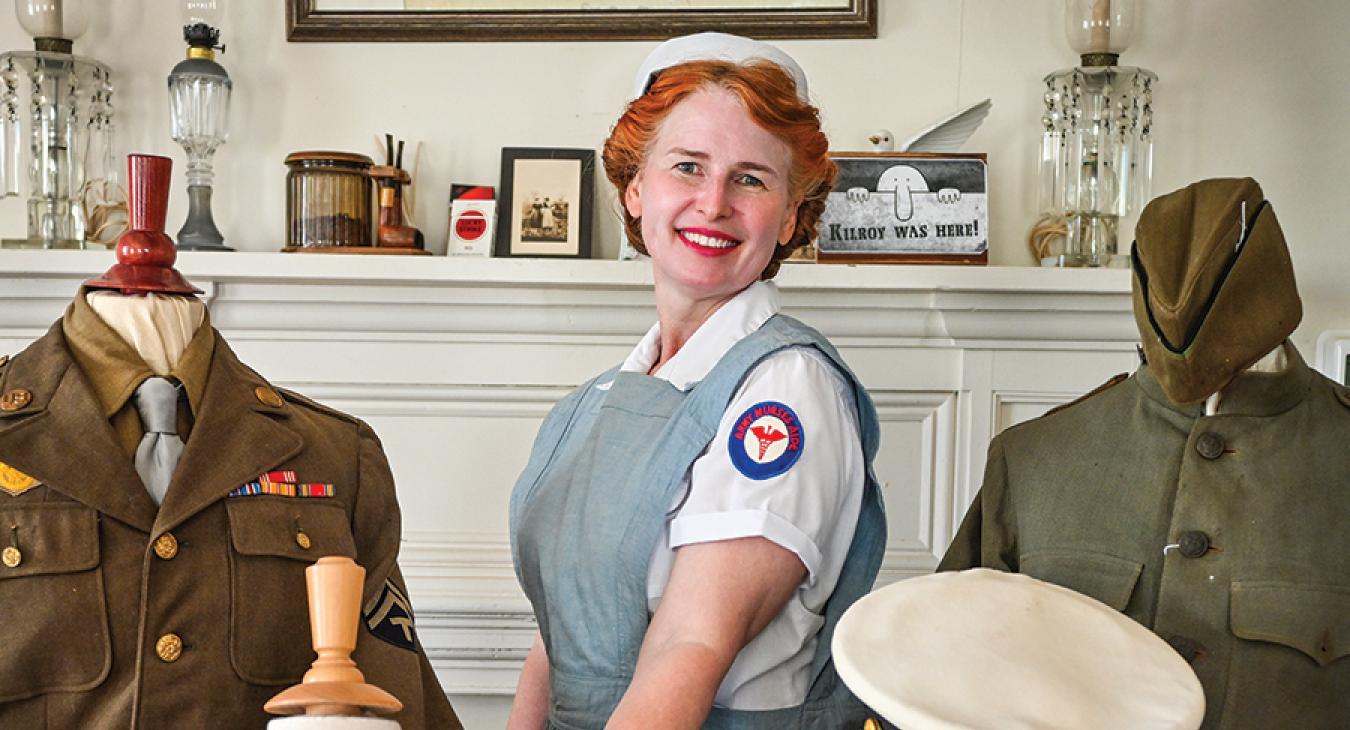Kelita Thomas, Lee County Museum curator and president of the county’s historical commission, selected the white Navy uniform, lower right, worn by M.F. Kieke during World War II as her ‘favorite thing’ in the museum. Sarah Beal photo
It was like asking a parent: Which is your favorite child?
Museums and historical archives across the Bluebonnet Electric Cooperative area are filled with thousands of fascinating items that have taken decades to select and acquire. It takes dedication and a love of history to tell the story of a community through a collection of artifacts.
But surely the folks in charge have a thing or two that holds a special place in their hearts. It could be something simple. Maybe it makes them remember a loved one or it symbolizes a key piece of their community’s past and people. Perhaps it just makes visitors chuckle.
We asked five Bluebonnet-area museum officials to pick out the one thing they could call their favorite. Each of their stories tells you something about them, their work and the vast array of preserved treasures tucked away in our communities.
1944 dress white Navy uniform
Chosen by Kelita Thomas
Lee County Museum
By Dana Frank
Lee County loves its military veterans. You can see it at Veterans Honor Park, just north of U.S. 290 and east of downtown Giddings, where flags, paver stones and an honor wall pay tribute to those from the county who are serving, or served, in the U.S. military.
The county also cherishes its history. All of that brings us to the Military Room at the Lee County Museum, where uniforms from all military branches, most worn during World War II, are on display. All were donated by Lee County residents.
Kelita Thomas likes to linger here. She has an affinity for the 1944 Navy dress white uniform bearing a lieutenant’s insignia and several medals that were worn by M.F. Kieke of Lee County. Thomas, the museum’s curator and president of Lee County’s historical commission, says she grew up “an Army brat” who is “very proud to be from a military family.” She always looked up to her older brother, Michael, who served in the Navy in a ship’s engine room.
“He has always been my hero,” Thomas said. “This uniform makes me think of my brother and all the other brave sailors who do so much to serve our country and keep us safe.” The man who wore the uniform on display was born in 1911.
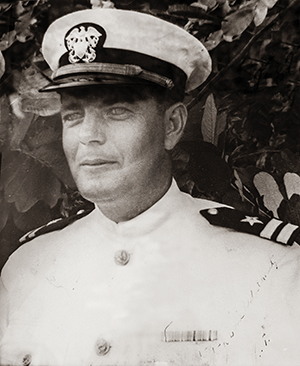
Kieke was aboard the USS Missouri on Sept. 2, 1945, when representatives of Japan signed surrender documents to the Allied Powers to end World War II. Kieke interrupted his career as an attorney in Lee County to serve his country from 1944 to 1946. His uniform bears an Asiatic Pacific Campaign Medal, a World War II Victory Medal and an honorable discharge emblem.
Thomas, who is also tourism director for the Giddings Chamber of Commerce, was instrumental in creating the Military Room in July 2021 to correspond with the Giddings Sesquicentennial and the opening of Veterans Honor Park and memorial.
Other uniforms in the museum’s Military Room include a U.S. Cadet Nursing Corps uniform and an Army uniform from World War I. The oldest item in the room is a sword from the Civil War, and the “prize of the collection,” Thomas said, is a World War I German water-cooled machine gun.
The Lee County Museum is housed, along with the Giddings Chamber of Commerce and Visitor’s Center, in the two-story Greek Revival–style Schubert-Fletcher home, which August Schubert built in 1879 for his wife and 10 children.
The Baylis Fletcher family bought the house in 1900, and donated it to the Lee County Heritage Society in the mid-1980s. The society donated the home to the county in 2017. It is listed on the National Register of Historic Places.
In addition to the Military Room, the front room of the museum displays the home’s original formal furnishings and décor, including the Schubert-Biar family piano and a framed painted Fletcher family tree that dates the family’s roots more than 900 years to 1066. A bedroom and kitchen are also part of this exhibit.
Completing the museum, which Johnson estimates contains 5,000 pieces, are a rotating exhibit and the Lee County History Room.
Kieke was raised in Lee County and went from practicing law to become Lee County Attorney in 1950 and county judge in 1953. He died in 1980 at age 69.
It is fitting that Giddings’ former city slogan, “Home of Opportunity,” was coined by his daughter, then-schoolgirl Twila Kieke. (Today’s city slogan is “Experience Hometown Hospitality.”)
Twila came up with the slogan in a 1950 competition and pocketed $10 for her idea. Perhaps her father’s life of military honor, hard work and success served as inspiration for her winning idea.
Lee County Museum
- 183 E. Hempstead St.,
- Giddings
- 979-542-3455
- Open 10 a.m.-5 p.m., Monday-Friday
- Free admission; donations accepted
Early 1900s custom-made saddle
Chosen by Mike Vance
Brenham Heritage Museum
By Dana Frank
A custom-made saddle allowed a young Dr. W.F. Hasskarl to make house calls after his 1910 arrival in Brenham.
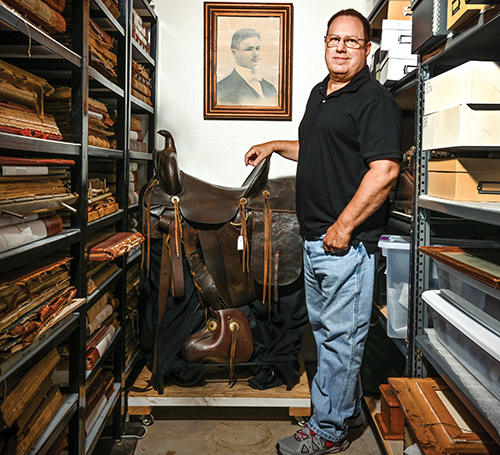
He quickly discovered he was not the only doctor in town, and most rural doctors of that era used carriages or horseback to get to the homes of patients. Cars were a rarity on the region’s dirt roads, though Hasskarl did get a Model T soon after his arrival in town.
To smooth horseback house calls, Hasskarl went to venerable Schramm Saddlery on Main Street in downtown Brenham. The business operated from the late 1800s through World War II. The craftsmen there created a sturdy dark-leather riding saddle that could accommodate medical supplies and equipment.
The well-used saddle, still in beautiful shape after a century, is part of the collection at the Brenham Heritage Museum in Washington County.
“It’s clear that the family took care of it,” said Mike Vance, executive director of the museum. “And we’ve made sure to protect it since it was donated by the doctor’s family a few decades ago.”
The saddle is a favorite of Vance’s because, he said, “It comes with a story that touches on a longtime business and an important family in town.” Vance is also a historian, an author and a documentary filmmaker.
The doctor’s son, Dr. W.F. (Boy) Hasskarl Jr., recounts in his memoir, “Remembering Brenham,” the story of his father and the saddle.
The saddle has a deep and comfortable cantle, which is the back of the saddle seat, to support the doctor’s hips and lower back. Behind the cantle, a wide, sturdy skirt secured saddlebags filled with medical supplies and necessities. The saddle’s stirrups are large, heavy and covered in thick leather. They offered stability and protection on Hasskarl’s rides through brush and branches, as well as some insulation on chilly middle-of-the-night rides.
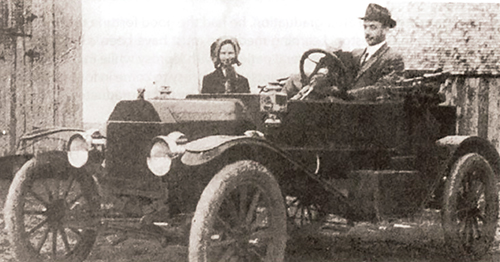
The elder Hasskarl, a graduate of the University of Texas Medical Branch at Galveston, was one of Brenham’s and Washington County’s most beloved doctors for decades. He was eventually joined by his son, who was born in Brenham and also graduated from the Galveston medical school. W.F. Hasskarl Jr., affectionately known as “Dr. Boy,” joined his father and a family friend, Dr. Thomas Giddings, at a medical practice that became the Brenham Clinic. The elder Hasskarl died in 1955 at age 70.
Dr. Boy, who served as an Air Force surgeon in the Korean War, worked as a physician in Brenham for 50 years, served two terms as the city’s mayor and was the Washington County health officer for 20 years. He died in 2008 at age 91.
The saddle will sit in the Brenham Heritage Museum space when renovations there are complete. The museum’s home is a 1916 former federal building and post office downtown that is expected to reopen to the public in September.
“Our goal is to create the best regional history museum in Texas,” Vance said. During renovation.
Brenham Heritage Museum
- Exhibits temporarily on display at Bus Depot Gallery, 313 E. Alamo St., Brenham
- Permanent facility, Post Office/Federal Building, 105 S. Market St., closed for renovations (completion expected in September 2022)
- 979-830-8445
- brenhamheritagemuseum.org
- Open 10 a.m.-4 p.m. Saturdays; Monday-Friday by appointment only
- Admission free for members, $5 for nonmembers; donations welcome
Early 20th century bogus medical device, the Nerv-O-Meter
Chosen by Rox Ann Johnson
Fayette Heritage Museum and Archives
By Dana Frank
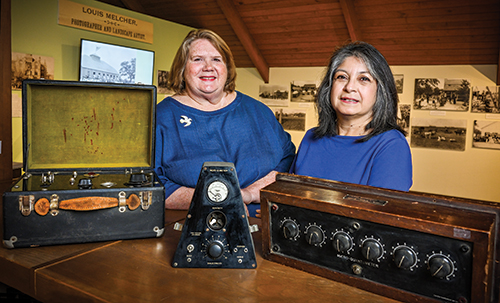
Feeling nervous and jittery? Worried about ... all of it? Considering a curative route but first need a diagnosis? Have we got the gadget for you.
Come see the Nerv-O-Meter at the Fayette Heritage Museum and Archives in La Grange. It is a favorite item of Rox Ann Johnson, an archivist and curator at the museum. The device is a splendid example of the many quack medical devices that became popular in the early 1900s.
The Nerv-O-Meter purports to gauge your “nervisity” (no, that’s not a word) in milliamperes with the help of its accompanying diagnostic instrument, the “micro-quantumeter” (also not a word). The device has an additional tool that, though important-looking in its briefcase-like container, has unstated powers.
During the early 1900s, the medical industry was essentially unregulated and devices like the Nerv-O-Meter were all the rage. Many purported to cure almost any malady, from arthritis to baldness to “neurasthenia,” a not-quite-real condition with symptoms of exhaustion, headache, irritability and general neuroses.
The bogus medical devices, often used by quack medical practitioners, varied in appearance and function and went by colorful names, including The Rejuvenator, violet ray wand, magneto and the Elec-Treat Mechanical Heart, according to reports and advertisements from the time. The devices often delivered low-level electric currents from custom batteries, because, in the early 1900s, electricity, magnetism and even radioactivity were touted as having curative properties.
The Nerv-O-Meter was used by a chiropractor whose office was above the Mohrhusen-Schmidt company, a furniture store at the corner of Main and Colorado streets in La Grange in Fayette County. “The store owner who found these instruments above his business many years ago cut the wires so that his children didn’t hurt themselves,” Johnson said. “Evidently, they liked to play doctor with them.”
The Nerv-O-Meter and its briefcase tool are labeled with the name Fred Besuzzi of Los Angeles. According to a 1955 false advertising lawsuit, Besuzzi was a businessman who loaned money or credit to licensed chiropractors “to enable them to open or buy offices and equipment under the association name of Basic Diagnostic Office.”
The device’s components were added to the museum’s collection more as an oddity than anything historical, Johnson said. “I could only speculate as to how old they are. My take is that they are pure quackery, but what do I know?”
Johnson and her colleague, Maria Rocha, design and create the museum’s exhibits and events. Not all holdings are on display, so if you visit when the Nerv-O-Meter is on hiatus, just ask to see it.
Don’t let the Nerv-O-Meter mislead you, though. The Fayette Heritage Museum and Archives is a research space, with worktables and more than 16,000 historical images in its research collection. It also holds over 17,000 files, documents, scrapbooks, maps and other written materials.
Fayette Heritage Museum and Archives
- 855 S. Jefferson St. (above the library), La Grange
- 979-968-3765 (ask for museum and archives)
- cityoflg.com/library (click on Museum & Archives)
- Open 10 a.m.-5 p.m. Tuesday-Friday; 10 a.m.-1 p.m. Saturday
- Free admission; donations accepted
1800s Czech hymnal, smuggled in a loaf of bread
Chosen by Christine Campbell
Burleson County Czech Heritage Museum
By Denise Gamino
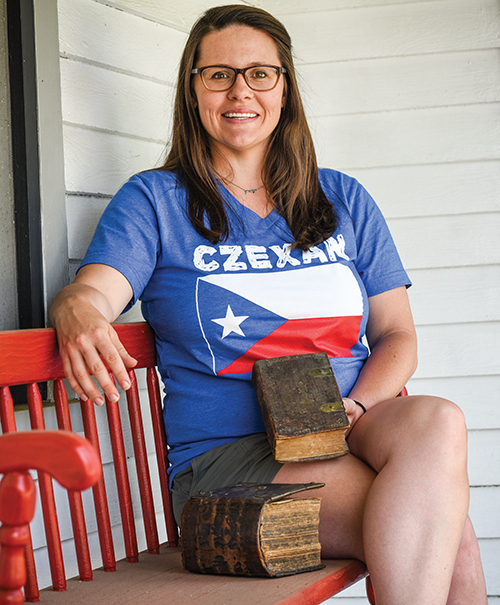
The thick brown book had no ticket to ride.
Instead, the vintage Czech holy book that is a Burleson County treasure is believed to have been smuggled out of Europe from what is now the Czech Republic in the 1800s. It was a time its people lived in servitude and their culture was suppressed under the strict Austrian-Hungarian Empire.
The stowaway full of songs and psalms apparently traveled inside an unconventional hiding place: a loaf of bread, according to its provenance document at the Burleson County Czech Heritage Museum and the family who donated it.
If the Protestant holy book had been found by the Empire, it would have been burned. An escape route of more than 5,000 miles brought the hymnbook to its display spot in Caldwell.
Museum president Christine Campbell says the Czech hymnal once considered contraband proves how important religion and culture were to the Czechs who left Europe for Texas.
“My favorite thing at the museum is our Czech hymnal,” she said. “The safety that our Czech ancestors risked to bring these important pieces with them sends a clear message of how important their faith was. We all have a lineage of something. To have a lineage of faith is a beautiful thing.”
Czechs began moving to Texas in the mid-19th century, mostly from Bohemia and Moravia. A 1906 Czech guidebook to a London exhibit about Bohemia states, “Three books are of striking importance and significance in the spiritual and moral development of the Bohemians: The Bible, The Postilla (Bible commentaries), and the Hymnbook.”
The chunky hymnal — 4 inches thick, 7 inches tall and 4.5 inches wide — is titled “Psalms and Hymns, Meditations.”
The publishing date is not known, but it’s signed by three men, including Jan Kanak. He wrote a note in the book: “Whoever finds this book should virtuously return it.”
John Orsag, an engineer retired from NASA’s Johnson Space Center in Houston, is a descendent of Kanak. He grew up in the Czech community of Hrozanka in Burleson County, east of Caldwell, where his parents spoke Czech. His mother, Ella (Zalmanek) Orsag, had a cousin who was a great-great-great grandson of Kanak. He gave Ella Orsag the smuggled Czech holy book because he had no children. About 10 years ago, John Orsag and his two sisters (Emily Orsag Hejl and Joyce Orsag Floeck) donated the book to the Czech Heritage Museum.

“We just decided that would be the best thing to do with it,” John Orsag said. “It was always passed down with the story about how the Bibles were oftentimes baked in bread just to hide them in a place where the authorities were not expected to find them so they could bring them over (to America) and keep them from being destroyed.”
Thadious Polasek, a Czech language instructor at Blinn College in Schulenburg and director of Schulenburg’s Public Library, translated portions of the Czech holy book.
“If, under Austrian-Hungarian rule, the books were found, the owner would (have been) punished,” Polasek said. “Any book in Czech would have had to be hidden in the Czech lands. The people had to be creative — be it in a loaf of bread, be it in a secret compartment in the floor or the well or some secret area of the house — so they would not be discovered when Austrians were coming into the town or walking through houses inspecting for books.
“The goal of the Austrian-Hungarian Empire was to wipe out the Czech culture, to Germanize the people,” he said.
“If you were going to be leaving your home (to emigrate), what are you going to take with you? You’re going to take your Bible, your medical books,” Polasek said. “If they had to get it through customs as they were traveling through the Austrian territory or checkpoint, they had to come up with ingenious ways of hiding it.”
The Czechs’ success in smuggling out their sacred religious books shows “a very deep love of their faith, their culture, their heritage,” Polasek said. “They knew the way to preserve it was to keep the books with them.”
Burleson County Czech Heritage Museum
- 200 E. Fawn St., Caldwell
- 979-567-0000 (Chamber of Commerce)
- Call for open hours or to schedule a visit
- Free admission; donations accepted
1930s bench made in Bastrop State Park
Chosen by Nicole Deguzman
Bastrop Museum and Visitor Center
By Dana Frank

Natural spaces — how they feel, look, sound and smell — are a big draw for Nicole DeGuzman. That’s why she relocated a year ago from West Texas to Bastrop, to become director of the Bastrop Museum and Visitor Center.
“Bastrop and Buescher state parks are some of the reasons I moved here,” she said.
Her favorite museum item represents that natural realm because it was hewn and crafted from walnut at Bastrop State Park in the 1930s by members of the federal Civilian Conservation Corps, or CCC. “The rustic style of this bench was meant to match and blend with the landscape of the park,” DeGuzman said, “just like the buildings and cabins, many of which are still standing.”
The simple wood bench was made before U.S. national park furniture design became standardized. “It is rare that the piece has survived intact,” DeGuzman said. The bench was loaned to the Bastrop County Historical Society in 1996 by the Texas Parks and Wildlife Department.
The hardworking bench isn’t glossy or flashy, and it is sturdy to this day. Museum visitors sometimes sit on it to gaze at exhibits, unaware they are sitting on a piece of Bastrop County history created by a Great Depression jobs program.
DeGuzman’s beloved bench has cedar cousins in the museum: a dining table and three chairs, all in the rustic style that harmonizes with the Lost Pines environment. The furniture at the museum was used in the park’s Refectory, or dining hall.
“A good portion of the original 1930s CCC-made furniture is still at the park,” according to Sally Baulch, the chief curator of the State Parks Cultural Resources Program at Texas Parks and Wildlife.
In the 1930s, President Franklin Roosevelt’s New Deal offered jobs to young unmarried men between ages 18 and 25 as part of the CCC to build out Bastrop State Park — as well as more than 800 other state and national parks.
Between 1934 and 1937, the Bastrop State Park furniture shop and mill turned out an estimated $75,000 worth of furniture for cabins and other buildings for parks nationwide. In today’s dollars, that is about $1.5 million.
That historic woodshop is still in use today. The brown signs familiar to visitors at any of Texas’ 89 state parks, historic sites and natural areas are made there. Bastrop State Park’s legendary handiwork now leaves a mark all around Texas.
Bastrop Museum and Visitor Center
- 904 Main St., Bastrop
- 512-303-0057
- bastropcountyhistoricalsociety.com
- Open 10 a.m.-5 p.m. Monday-Saturday
- Admission $5; free for 12 and younger and veterans





